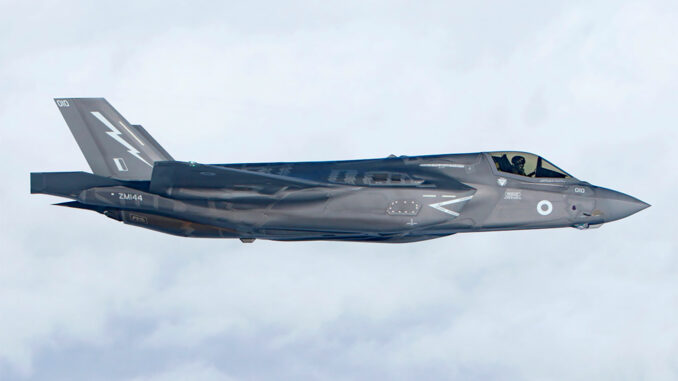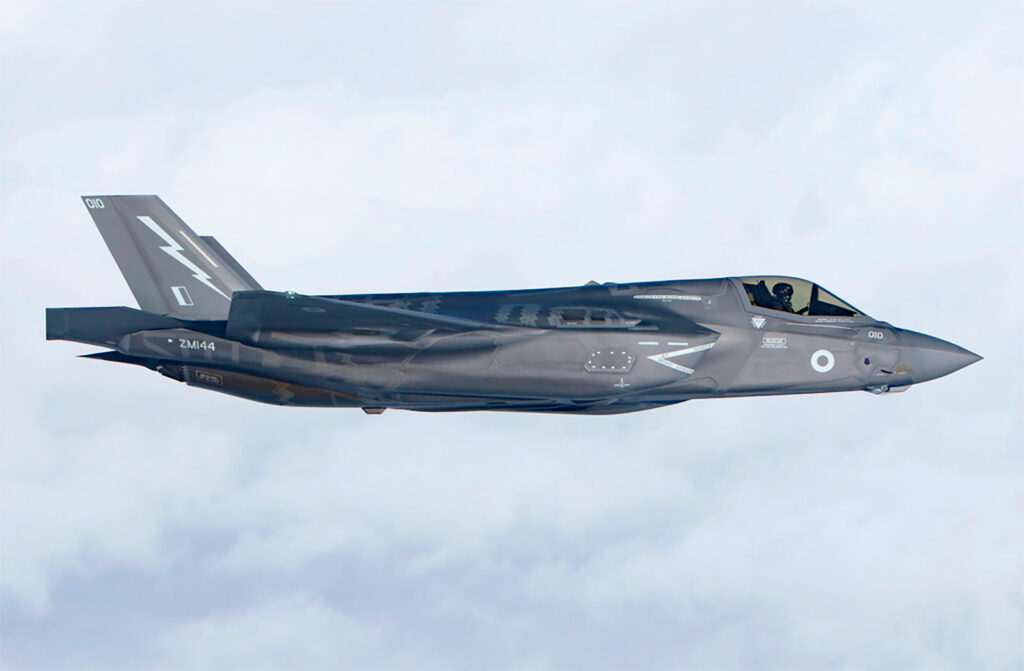
A parliamentary report slams the British F-35 program: lack of stand-off munitions, delays, staff shortages, and total cost reevaluated at £57 billion.
Summary
The latest report from the Public Accounts Committee (PAC) highlights serious shortcomings in the British Ministry of Defense (MoD)’s F-35 program. Despite the aircraft’s technical sophistication, years of budget cuts have compromised its operational capability. The B version (short takeoff and landing) still lacks stand-off missiles, delaying any safe long-range strike capability until the early 2030s. The MoD lacks specialized technicians and engineers, which is hampering the availability of the aircraft. The program’s life-cycle cost has skyrocketed: what was estimated at £18.4 billion for 48 aircraft has now reached £57 billion for 138 aircraft, not including fuel, personnel, or infrastructure. The report calls for an urgent review of budgetary choices and alignment between strategic ambitions and actual resources.
The context and challenges of the British F-35 program
The United Kingdom has chosen to equip itself with the F-35 to modernize its air and naval fleets. The aircraft is designed to provide stealth capability, advanced detection systems, and integration into joint operations. The MoD plans to acquire a total of 138 aircraft, combining the “B” version for carrier-based capabilities and the more conventional “A” version, particularly for NATO’s nuclear mission.
However, the PAC report reveals that these ambitions are hampered by long-term budgetary choices, where short-term savings have undermined the foundations of the program. The result: a potentially first-rate aircraft, but one whose actual performance is seriously in question.
Critical shortcomings identified by the report
A stand-off munitions deficit
The most striking criticism concerns the lack of long-range strike capability. The British F-35B currently only has guided bombs, such as the Paveway IV, which are ill-suited to strikes against targets protected by modern air defenses.
The missile designed to address this shortfall, SPEAR 3, is suffering from delays: its integration into the F-35 has been pushed back to the early 2030s.
In the meantime, the UK is considering purchasing Small Diameter Bomb II (SDB II / StormBreaker) as a transitional solution, but funding has not yet been secured.
The lack of stand-off munitions seriously compromises the relevance of the British F-35 in a contested environment where surviving enemy air defenses depends on long-range attacks.
A shortage of qualified personnel
The report points to a structural problem: the MoD did not correctly assess the number of engineers, technicians, cyber specialists, pilots, and instructors needed to support an F-35 fleet.
To correct this, 168 additional positions—approximately 20%—are planned, but filling them will take several years. In 2025, only 5 of the 16 flight instructor positions were filled.
This shortage of personnel has led to reduced aircraft availability. The report indicates that in 2024, the British fleet achieved only one-third of its planned mission objectives.
The impact on operational effectiveness is significant: a lack of technicians delays maintenance, limits aircraft rotations, and compromises responsiveness in the event of a crisis.
Neglected infrastructure
The main F-35 base, RAF Marham, is also singled out. The report describes housing that is considered “degraded”: lack of hot water, insufficient access to public transportation, and substandard living conditions for personnel mobilized on a strategic program.
Improvements to this infrastructure are planned… for 2034. The committee considers this deadline too far off, believing it to be incompatible with the needs of personnel recruitment and retention.
Similarly, the construction of vital facilities such as the Aircraft Signature Assessment Facility, which is essential for evaluating the stealth capabilities of the F-35, has been delayed in order to save a few million pounds—a decision considered to be short-sighted.
The overall cost of the program: a skyrocketing bill
Originally, in 2013, the MoD estimated the cost for the first 48 aircraft at £18.4 billion.
With the extension to 138 aircraft and a service horizon pushed back to 2069, the life-cycle cost has been re-evaluated at £57 billion.
However, this amount does not include fuel, staff salaries, routine maintenance, infrastructure, or any future upgrades. The independent National Audit Office (NAO) estimates that the actual cost over the entire lifetime could reach £71 billion.
Paradoxically, short-term decisions to postpone or cut costs—delayed deliveries, infrastructure delays, staff shortages—lead to significant long-term cost increases.
In addition, the introduction of the F-35A version, intended for NATO’s nuclear mission, could generate additional costs related to certification, training, and infrastructure compliance. No precise figures have been provided.
The consequences for the Royal Air Force and the Royal Navy
Reduced availability and diminished operational capabilities
With only a third of missions completed in 2024, the British F-35 fleet is struggling to meet its objectives.
The shortage of engineers and technicians is slowing down maintenance. Aircraft are grounded for longer periods, compromising rotations, overseas deployment, and availability in the event of a crisis.
The lack of stand-off munitions means that in the event of a conflict against an adversary with advanced air defenses, the F-35B will not be able to strike safely. Its use in a ground attack role would therefore be risky, if not ineffective.
Risks to the credibility of aircraft carriers
The two British aircraft carriers rely heavily on the F-35B to provide air combat, strike, and air superiority capabilities. If these aircraft do not have the right weapons, the credibility of the naval fleets in operation is compromised. In addition, the fleet is weakened by deferred maintenance, even though the goal of two full squadrons by the end of 2025 is based on promises that are difficult to keep.
Impact on personnel and cohesion
Inadequate housing and living conditions at the main F-35 base are detrimental to morale, personnel retention, and the attractiveness of the program. In the long term, this could lead to an exodus of technicians and pilots to other forces or to civilian life.
Delays in recruitment and training—particularly of instructors—jeopardize the desired ramp-up and risk creating a lasting bottleneck.
What would happen if the UK canceled some orders?
The report does not explicitly address cancellation, but several scenarios could arise if the MoD chooses to reduce the number of F-35s ordered or slow down the program.
- The unit cost of each aircraft could increase as economies of scale disappear. Maintenance, infrastructure, and logistical support would still need to be spread across a reduced number of aircraft, making the program even less cost-effective.
- The UK’s air and naval projection capabilities would be diminished. Fewer aircraft means fewer possible rotations, increased pressure on the remaining aircraft, and a loss of strategic flexibility, particularly for carrier-based operations.
- The already limited effectiveness of air strikes would become more uncertain. Without stand-off munitions and with a reduced fleet, the Royal Navy and Royal Air Force could lose their operational superiority, at least in certain “high-intensity” combat scenarios.
- The sunk costs already incurred would not be canceled: the sums paid, the partially constructed infrastructure, and the maintenance of inactive personnel would still be costly. The PAC report notes the negative impact of this budgetary instability on the confidence of allies and the effectiveness of defense commitments.
In the absence of a credible upgrade plan (personnel, weapons, infrastructure), a reduction in the program would risk preserving only the risk — without offering any tangible strategic advantage.

The source of the errors: short-termism and poor management
The PAC report likens the MoD’s decisions to those of a homeowner who indefinitely postpones repairs to a leaky roof; minor savings today, but serious consequences tomorrow.
Deferring the construction of essential infrastructure (such as the ASAF), delaying the delivery of aircraft, not recruiting technicians or engineers quickly enough, postponing the purchase of key munitions… all these choices, taken together, transform a cutting-edge program into a deficient project.
The PAC criticizes the program’s cost projection: the £57 billion announced between now and 2069 does not include personnel, fuel, maintenance, and modernization costs, nor the uncertainties associated with the evolution of missions. This figure therefore appears to be underestimated.
Finally, the addition of the F-35A version for NATO’s nuclear mission was decided before the MoD had fully understood the necessary technical, human, and infrastructural requirements. The report considers this decision premature, with the risk of generating unforeseen additional costs.
What the report calls for—and what it reveals
The PAC makes several clear demands:
- Provide a detailed plan specifying how the UK intends to acquire a credible stand-off capability before the integration of SPEAR 3.
- Implement an ambitious and realistic recruitment and retention strategy for engineers, technicians, pilots, and instructors.
- Rapidly improve accommodation and support infrastructure at RAF Marham to prevent staff attrition.
- Review program governance to prevent short-term decisions from leading to major long-term cost overruns.
These remarks reveal a stark reality: 5th generation aircraft technology alone is not enough. Without adequate human, logistical, budgetary, and strategic support, the British F-35 risks remaining a “promising” but ineffective aircraft, especially in a high-threat environment.
Towards a turning point for British defense
The PAC report could serve as a wake-up call. It highlights a broader problem: the difficulty for states to reconcile military ambitions, budgetary constraints, and industrial realities. In the case of the F-35, the mistake is not technological but institutional and organizational.
If the MoD agrees to rethink its approach—placing the long term above immediate savings—there is still a window of opportunity to turn the program around. This will require massive recruitment, serious funding for ammunition and infrastructure, and more rigorous cost management.
If nothing changes, the UK risks not only wasting tens of billions of pounds, but more importantly, finding itself without a credible air superiority tool at a time when strategic demand could be at its highest.
Sources
Public Accounts Committee report “The UK’s F-35 stealth fighter capability” (October 2025)
Article “Ministry of Defense’s F-35 blunder: £57B and counting” – The Register (November 2025)
Analysis “UK’s F-35: advanced technology shot down by poor management” – Aviacionline Defense (November 2025)
Article “MOD cost-cutting crippled RAF’s F-35 capability” – Forces News (October 2025)
Article “UK questioned on F-35 standoff weapons gap” – UK Defense Journal (November 2025)
Data on SPEAR 3 (development history) – Wikipedia (2025)
War Wings Daily is an independant magazine.